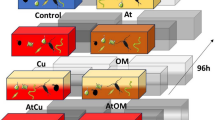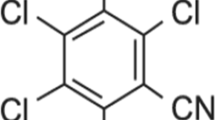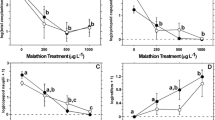Abstract
The effects of the insecticide chlorpyrifos were studied in plankton-dominated mesocosms under Mediterranean conditions. Chlorpyrifos was applied four times at 1 week intervals at nominal concentrations of 0.033, 0.1, 0.33, and 1 μg/l simulating repeated agricultural applications. The lowest 7 days time weighted averaged concentrations (TWAC) during the 28 days exposure period were calculated using the FOCUS equation to express the no observed effect concentration (NOEC) values. At population level the lowest NOEC calculated was 0.012 μg/l (treatment concentration 0.033 μg/l). The most affected taxon was Cladocera (Daphnia group galeata) followed by Copepoda (cyclopoids and nauplii). No effects were observed on phytoplankton (chlorophyll-a biomass) at any treatment level. The smallest NOECcommunity calculated by means of multivariate techniques was 0.1 μg/l when expressed in terms of the nominal treatment level and 0.074 μg/l when based on the lowest 7 days TWA concentration during the 28 days application period. Indirect effects on zooplankton populations were observed due to shifts in competition and predation between populations. Compared with previous micro/mesocosm experiments simulating a single application exposure regime, results from our study revealed a lower threshold level for the most sensitive measurement endpoint (difference a factor of three (in terms of nominal treatment level), more severe indirect effects and longer recovery periods of the affected populations (>13 weeks in the test systems treated with 1 μg/l). These differences could be attributed to the repeated pulse exposure scenario approach designed for our studies together with the particular climatic conditions involving our Mediterranean mesocosms (i.e., temperature, cladocerans life history, and algae blooms).







Similar content being viewed by others
References
Alonso M (1996) Fauna Ibérica. 7: crustacea branchiopoda. MNCN, Fauna Ibérica Project Publications, Madrid, Spain
American public health association (APHA) (1995) Standard methods for the examination of water and wastewater, 19th ed. Washington DC, USA
Amoros C (1984) Introduction practique a la systematique des organismes des eaux continentals françaises. Vol 5: crustacés Cladocères. Association française de limnologie, Lyon, France
Barron MG, Woodburn KB (1995) Ecotoxicology of chlorpyrifos. Rev Environ Contam Toxicol 144:1–93
Barnthouse LW (2004) Quantifying population recovery rates for ecological risk assessment. Environ Toxicol Chem 23:500–508. doi:10.1897/02-521
Benzie JAH (2005) Guides to the identification of the microinvertebrates of the continental waters of the world. 21: Cladocera: the genus Daphnia (including Daphniopsis) (Anomopoda: Daphniidae). Academic Publishing, The Hague, The Netherlands
Bernot RJ, Dodds WK, Quist MC, Guy CS (2006) Temperate and kairomone induced life history plasticity in coexisting Daphnia. Aquat Ecol 40:361–372. doi:10.1007/s10452-006-9035-5
Biever RC, Giddings JM, Kiamos M, Annunziato MF, Meyerhoff R, Racke K (1994) Effects of chlorpyrifos on aquatic microcosms over a range of off-target drift exposure levels. Proceedings of the Brighton crop protection conference. Pests diseases. British Crop Protection Council, Farnham Surrey, UK, pp 1367–1372
Boesten JJTI, Köpp H, Adriaanse PI, Brock TCM, Forbes VE (2007) Conceptual model for improving the link between exposure and effects in the aquatic risk assessment of pesticides. Ecotoxicol Environ Saf 66:291–308. doi:10.1016/j.ecoenv.2006.10.002
Boxall A, Brown C, Barrett K (2001) Higher tier laboratory aquatic toxicity testing. Cranfield Centre for EcoChemistry, UK. Research report no. JF 4317E for DETR
Brazner JC, Heinis LJ, Jensen DA (1989) A littoral enclosure for replicated field experiments. Environ Toxicol Chem 8:1209–1216. doi:10.1897/1552-8618(1989)8[1209:ALEFRF]2.0.CO;2
Brazner JC, Kline ER (1990) Effects of chlorpyrifos on the diet and growth of larval fathead minnow, Pimephales promelas. Can J Fish Aquat Sci 47:1157–1165
Brock TCM, Crum SJ, Van Wijngaarden RPA, Budde BJ, Tijink J, Zuppelli A et al (1992a) Fate and effects of the insecticide Dursban® 4E in indoor Elodea-dominated and macrophyte-free freshwater model ecosystems: I fate and primary effects of the active ingredient chlorpyrifos. Arch Environ Contam Toxicol 23:69–84
Brock TCM, Van den Bogaert M, Boss AR, Van Breukelen SWF, Reiche R, Terwoert J et al (1992b) Fate and effects of the insecticide Dursban® 4E in indoor Elodea-dominated and macrophyte-free freshwater model ecosystems: II. Secondary effects on community structure. Arch Environ Contam Toxicol 23:391–409
Brock TCM, Vet JJRM, Kerkhofs MJJ, Lijzen J, Van Zuilekom WJ, Gijlstra R (1993) Fate and effects of the insecticide Dursban® 4E in indoor Elodea-dominated and macrophyte-free freshwater model ecosystems: III. Aspects of ecosystem functioning. Arch Environ Contam Toxicol 25:160–169. doi:10.1007/BF00212127
Brock TCM, Van Wijngaarden RPA, Van Geest G (2000) Ecological risks of pesticides in freshwater ecosystems. Part 2: Insecticides. Report 089, Alterra, Wageningen, The Netherlands.
Brock TCM, Arts GHP, Maltby L, Van den Brink PJ (2006) Aquatic risks of pesticides, ecological protection goals, and common aims in European Union legislation. Integr Environ Assess Manag 2:e20–e46. doi:10.1897/1551-3793(2006)2[e20:AROPEP]2.0.CO;2
Chang KH, Sakamoto M, Hanazato T (2005) Impact of pesticide application on zooplankton communities with different densities of invertebrate predators: An experimental analysis using small-scale mesocosms. Aquat Toxicol 72:373–382. doi:10.1016/j.aquatox.2005.02.005
Crum SJH, Brock TCM (1994) Fate of chlorpyrifos in indoor microcosms and outdoor experimental ditches. In: Hill IA, Heimbach F, Leeuwangh P, Matthiesen P (eds) Freshwater field tests for hazard assessment of chemicals. Lewis Boca Raton, FL, USA, pp 315–322
Cuppen JGM, Crum SJH, Van den Heuvel HH, Smidt RA, Van den Brink PJ (2002) The effects of a mixture of two insecticides on freshwater microcosms. I. Fate of insecticides and responses of macroinvertebrates. Ecotoxicology 11:165–180. doi:10.1023/A:1015470731330
Ecological Committee on FIFRA Risk Assessment Methods (ECOFRAM) (1999) ECOFRAM draft Aquatic Report. US Enviromental Protection Agency
European Union (2000) Directive 2000/60/EC of the European parliament and of the council of 23 October 2000 establishing a framework for Community action in the field of water policy. Water Framew Directive. Off J Eu Comm L 327(1)
Expert advisory forum on priority substances (EAF) and Expert Group of Quality Standards, (2005) Common implementation strategy for the water framework directive (2000/60/EC). Environmental quality standards (EQS). Priority substance no. 9 Chlorpyrifos. Brussels, Belgium.
Fleeger JW, Carman KR, Nisbet RM (2003) Indirect effects of contaminants in aquatic ecosystems. Sci Total Environ 317:207–233. doi:10.1016/S0048-9697(03)00141-4
Forum for the coordination of pesticides fate models and their use (FOCUS) (2001) FOCUS surface water scenarios in the EU evaluation process under 91/414/EEC. EC Document SANCO/4802/2001. Report of the FOCUS Working Group on Surface Water Scenarios, Brussels, Belgium
Gilbert JJ (1985) Competition between rotifers and Daphnia. Ecology 66:1943–1950. doi:10.2307/2937390
Gilbert JJ (1988) Susceptibilities of ten rotifer species to interference from Daphnia pulex. Ecology 69:1826–1838. doi:10.2307/1941160
Graney RL, Kennedy JH, Rodgers JH (1994) Aquatic mesocosm studies in ecological risk assessment. Lewis, Boca Raton, FL, USA
Hanazato T, Yasuno M (1990) Influence of persistence period of an insecticide on recovery patterns of a zooplankton community in experimental ponds. Environ Pollut 67:109–122
Hanazato T (1998) Response of a zooplankton community to insecticide application in experimental ponds: a review and the implications of the effects of chemicals on the structure and functioning of freshwater communities. Environ Pollut 101:361–373. doi:10.1016/S0269-7491(98)00053-0
Hanazato T (2001) Pesticide effects on freshwater zooplankton: an ecological perspective. Environ Pollut 112:1–10. doi:10.1016/S0269-7491(00)00110-X
Hickie BE, McCarty LS, Dixon DG (1995) A residue-based toxicokinetic model for pulse exposure toxicity in aquatic systems. Environ Toxicol Chem 14:2187–2197. doi:10.1897/1552-8618(1995)14[2187:ARTMFP]2.0.CO;2
Hill IA, Heimbach F, Leeuwangh P, Matthiesen P (eds) (1994) Freshwater field tests for hazard assessment of chemicals. Lewis, Boca Raton, FL, USA
Hommen U, Veith D, Ratte HT (1994) A computer program to evaluate plankton data from freshwater field test. In: Hill IA, Heimbach F, Leeuwangh P, Matthiesen P (eds) Freshwater field tests for hazard assessment of chemicals. Lewis, Boca Raton, FL, USA, pp 503–513
Hughes DN, Boyer MG, Papst MH, Fowle CD, Rees GAV, Baulu P (1980) Persistence of three organophosphorus insecticides in artificial ponds and some biological implications. Arch Environ Contam Toxicol 9:269–279. doi:10.1007/BF01057407
Hurlbert SH, Mulla MS, Willson HR (1972a) Effects of an organophosphorus insecticide on the phytoplankton, zooplankton, and insect populations of freshwater ponds. Ecol Monogr 42:269–299. doi:10.2307/1942211
Hurlbert SH, Mulla MS, Keith JO, Westlake WE, Dusch ME (1972b) Biological effects and persistence of Dursban® on freshwater ponds. J Econ Entomol 63:43–52
Kerfoot WC, Levitan C, DeMott WR (1988) Daphnia–phytoplankton interactions: dependent shifts in resource quality. Ecology 69:1806–1825. doi:10.2307/1941159
Kersting K, Van Wijngaarden RPA (1992) Effects of chlorpyrifos on a microecosystem. Environ Toxicol Chem 11:365–372. doi:10.1897/1552-8618(1992)11[365:EOCOAM]2.0.CO;2
Kersting K, Van den Brink PJ (1997) Effects of the insecticide Dursban® 4E (a.i. chlorpyrifos) in outdoor experimental ditches. Responses of ecosystem metabolism. Environ Toxicol Chem 16:251–259. doi:10.1897/1551-5028(1997)016<0251:EOTIDA>2.3.CO;2
Leeuwangh P, Brock TCM, Kersting K (1994) An evaluation of four types of freshwater model ecosystem for assessing the hazard of pesticides. Hum Exp Toxicol 13:888–899
Lopez T, Gabellone N, Toja J (1991) Limnological comparison between two peridunar ponds in the Doñana national park (SW Spain). Arch Hydrobiol 120:357–378
López-Mancisidor P, Carbonell G, Marina A, Fernández C, Tarazona JV (2007) Zooplankton community responses to chlorpyrifos in mesocosms under Mediterranean conditions. Ecotoxicol Environ Saf (in press)
López-Mancisidor P, Van den Brink PJ, Crum SJH, Maund SJ, Carbonell G, Brock TCM (2008) Responses of zooplankton in lufenuron-stressed experimental ditches in the presence or absence of uncontaminated refuges. Environ Toxicol Chem 27:1317–1331. doi:10.1897/07-270.1
Lucassen WGH, Leeuwangh P (1994) Responses of zooplankton to Dursban® 4E insecticide in a pond experiment. In: Graney RL, Kennedy JH, Rodgers JH (eds) Aquatic mesocosm studies in ecological risk assessment. Lewis, Boca Raton, USA, pp 517–533
Marshall WK, Roberts JR (1978) Ecotoxicology of chlorpyrifos. NRCC 16079 Report. National Research Council of Canada, Ottawa, Ontario
Ministerio de Agricultura Pesca y Alimentación (2002) Real Decreto 1201/2002, de 20 de noviembre, por el que se regula la producción integrada de productos agrícolas. Boletín Oficial del Estado, Madrid, España
Ministerio de Agricultura Pesca y Alimentación (2004) Orden APA/1657/2004, de 31 de mayo. por la que se establece la norma técnica específica de la identificación de garantía nacional de producción integrada de cítricos. Boletín Oficial del Estado, Madrid, España
Nogrady T, Alai M (1983) Cholinergic neurotransmission in rotifers. Hydrobiologia 104:149–153. doi:10.1007/BF00045962
Parsons JT, Sturgeoner GA (1991) Acute toxicity of permethrin, fenitrothion, carbaryl, and carbofuran to mosquito larvae during single or mutliple-pulse exposures. Environ Toxicol Chem 10:1229–1233. doi:10.1897/1552-8618(1991)10[1229:ATOPFC]2.0.CO;2
Preston BL (2002) Indirect effects in aquatic ecotoxicology: implications for ecological risk assessment. Environ Manage 29:311–323. doi:10.1007/s00267-001-0023-1
Pusey BJ, Arthington AH, McClean J (1994) The effects of a pulsed application of chlorpyrifos on macroinvertebrate communities in an outdoor artificial stream system. Ecotoxicol Environ Saf 27:221–250. doi:10.1006/eesa.1994.1019
Racke KD (1992) Environmental fate of Chlorpyrifos. Rev Environ Contam Toxicol 131:1–150
Reinert KH, Giddings JM, Judd L (2002) Effects analysis of time-varying or repeated exposures in aquatic ecological risk assessment of agrochemicals. Environ Toxicol Chem 21:1977–1992. doi:10.1897/1551-5028(2002)021<1977:EAOTVO>2.0.CO;2
Santé des Consommateurs (SANCO) (2002) Guidance document on aquatic ecotoxicology in the context of the Directive 91/414/EEC. European Commission, Health & Consumer Protection Directorate-General, SANCO/3268/2001 rev. 4 (final). Brussels, Belgium.
Serrano L, Toja J (1998) Interannual variability in the zooplankton community of a shallow temporary pond. Verh Int Ver Theor Angew Limnol 26:1575–1581
Siefert RE, Lozano SJ, Brazner JC, Knuth ML (1989) Littoral enclosures for aquatic field testing of pesticides: effects of chlorpyrifos on a natural system. Miscellaneous Publ Ser Entomol Soc Am 75:57–73
Soto D, Hurlbert SH (1991) Long-term experiments on calanoid–cyclopoid interactions. Ecol Monogr 61:245–265. doi:10.2307/2937108
Stark JD, Wennergren U (1995) Can population effects of pesticides be predicted from demographic toxicological studies? J Econ Entomol 85:1089–1096
Statistical Office of the European Communities (EUROSTAT) Agriculture, forestry and fisheries data: agricultural products. Available at the internet-site: http://www.epp.eurostat.ec.europa.eu
Stay FS, Flum TE, Shannon LJ, Young JD (1989) An assessment of the precision and accuracy of SAM and MFC microcosms exposed to toxicants. In: Cowgill UM, Williams LR (eds) Aquatic toxicology and hazard assessment: 12th volume. ASTM STP 1027. Am Soc Testing Materials, Philadelphia, pp 189–203
Tarazona JV (2005) Geographical differences in the evaluation and prediction of the effects of pesticides. In: Liess M, Brown C, Dohmen P, Duquesne S, Hart A, Heimbach F, Kreuger J, Lagadic L, Maund S, Reinert W, Streloke M, Tarazona JV (eds) Effects of pesticides in the field. Society of environmental toxicology and chemistry (SETAC). Brussels, pp 102–104
Ter Braak CJF, Smilauer P (2002) CANOCO Reference Manual and CanoDraw for Windows User’s Guide: Software for Canonical Community Ordination. Version 4.5. Microcomputer Power, Ithaca NY, USA
Thorp JH, Covich AP (2001) Ecology and classification of North American freshwater invertebrates, 2nd edn. Academic Press, London, UK
Touart L (1988) Guidance document for aquatic mesocosm tests to support pesticide registrations. EPA 540/09//88/035. Environmental Protection Agency, Washington, DC
Van den Brink PJ, Van Donk E, Gylstra R, Crum SJH, Brock TCM (1995) Effects of chronic low concentrations of the pesticides chlorpyrifos and atrazine in indoor fresh-water microcosms. Chemosphere 31:3181–3200. doi:10.1016/0045-6535(95)00180-G
Van den Brink PJ, Van Wijngaarden RPA, Lucassen WGH, Brock TCM, Leeuwangh P (1996) Effects of the insecticide Dursban® 4E (active ingredient chlorpyrifos) in outdoor experimental ditches 2. Invertebrate community responses and recovery. Environ Toxicol Chem 15:1143–1153. doi:10.1897/1551-5028(1996)015<1143:EOTIDA>2.3.CO;2
Van den Brink PJ, Ter Braak CJF (1998) Multivariate analysis of stress in experimental ecosystems by principal response curves and similarity analysis. Aquat Ecol 32:163–178. doi:10.1023/A:1009944004756
Van den Brink PJ, Ter Braak CJF (1999) Principal response curves: analysis of time-dependent multivariate responses of biological community to stress. Environ Toxicol Chem 18:138–148. doi:10.1897/1551-5028(1999)018<0138:PRCAOT>2.3.CO;2
Van den Brink PJ, Hattink J, Bransen F, Van Donk E, Brock TCM (2000) Impact of the fungicide carbendazim in freshwater microcosms II. Zooplankton, primary producers and final conclusions. Aquat Toxicol 48:251–264. doi:10.1016/S0166-445X(99)00037-5
Van Wijngaarden RPA, Leeuwangh P, Lucassen WGH, Romijn K, Ronday R, Van der Velde R et al (1993) Acute toxicity of chlorpyrifos to fish, a newt, and aquatic invertebrates. Bull Environ Contam Toxicol 51:716–723. doi:10.1007/BF00201650
Van Wijngaarden RPA, Brock TCM, Douglas MT (2005a) Effects of chlorpyrifos in freshwater model ecosystems: the influence of experimental conditions on ecotoxicological thresholds. Pest Manag Sci 61:923–935. doi:10.1002/ps.1084
Van Wijngaarden RPA, Brock TCM, Van den Brink PJ (2005b) Threshold levels for effects of insecticides in freshwater ecosystems: a review. Ecotoxicology 14:355–380. doi:10.1007/s10646-004-6371-x
Van Wijngaarden RPA, Van den Brink PJ, Crum SJH, Oude Voshaar JH, Brock TCM, Leeuwangh P (1996) Effects of the insecticide Durban 4®E (a.i. chlorpyrifos) in outdoor experimental ditches: I. Comparison of short-term toxicity between laboratory and field. Environ Toxicol Chem 15:1133–1142
Vanni MJ, Lampert W (1992) Food quality effects on life history traits and fitness in the generalist herbivore Daphnia. Oecologia 92:48–57. doi:10.1007/BF00317261
Waters Corporation (2002) Environmental & agrochemical applications notebook, Rev 3. Massachussetts, USA, pp 9
Williams DA (1972) The comparison of several dose levels with a zero dose control. Biometrics 28:519–531. doi:10.2307/2556164
Williamson CE (1980) The predatory behaviour of Mesocyclops edax; predator preferences, prey defenses and starvation induced changes. Limnol Oceanogr 25:903–909
Zakai NP (1984) Predation of Cyclops vicinus (Copepoda Cyclopoidea) on small zooplankton animals in Lake Balaton (Hungary). Arch Hydrobiol 99:306–378
Acknowledgments
The authors thank Ana Marina, Luis Zazo, Juan Carlos Bravo and Adolfo González for their technical assistance. This research was supported by a National Research Project from the Spanish Ministry of Education and Science (REN2003-06917-C02-01). Work was performed while P López-Mancisidor was Conservational Biology doctoral student, supported by an INIA Project (RTA 01-045).
Author information
Authors and Affiliations
Corresponding author
Rights and permissions
About this article
Cite this article
López-Mancisidor, P., Carbonell, G., Fernández, C. et al. Ecological impact of repeated applications of chlorpyrifos on zooplankton community in mesocosms under Mediterranean conditions. Ecotoxicology 17, 811–825 (2008). https://doi.org/10.1007/s10646-008-0239-4
Received:
Accepted:
Published:
Issue Date:
DOI: https://doi.org/10.1007/s10646-008-0239-4




